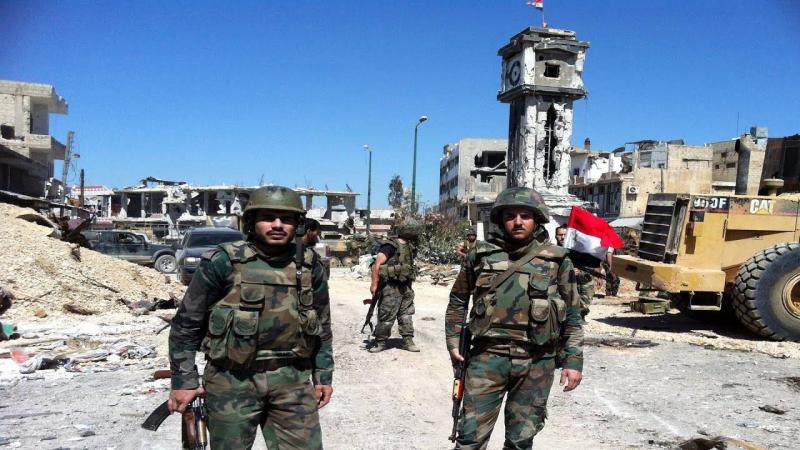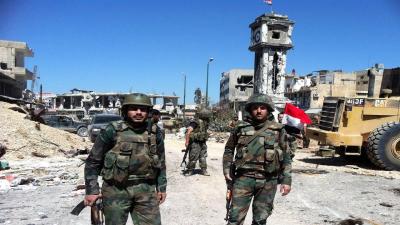The Syrian Observatory for Human Rights has documented the fatalities of 675 members of the Syrian regime’s forces from the beginning of this year until mid-June. Although a significant portion of this number is linked to attacks by ISIS, the statistics indicate a general state of "exhaustion" that is not limited to a specific area but affects various geographical locations. The statistics show that 330 members were killed by the organization between January and June, while the remaining 345 died in incidents and attacks that varied between internal conflicts, security breaches, assassinations, and killings by opposing factions and militants.
The director of the observatory, Rami Abdel Rahman, told Al-Hurra that this indicates that "the Syrian regime army does not genuinely control the areas of its presence, even along the front lines in northern Syria and in Daraa in the south." He adds that the "shocking" documented number of regime casualties is associated with several factors, whether in the Badiyah region, which has been experiencing attacks, ambushes, and assassinations for years, or in areas that are nominally under the control of Assad’s regime and forces, but the reality on the ground is different.
After 2018, military operations on the ground in Syria diminished, marking a pivotal moment in which the Syrian regime forces fully controlled Daraa province in the south and solidified their presence at the contact lines with opposition factions in the north. However, despite the regime's military and security control over Daraa, the Observatory's statistics indicate that the death toll has continued in the southern region due to various incidents, including assassinations and bombings.
This same scene also prevails in the Syrian Badiyah, where the highest number of Assad’s forces have been killed, despite the regime announcing multiple times its control over these vast areas, following a series of security campaigns mostly supported by Russia.
**"Exhaustion" Has Causes and Indicators**
Since losing its last urban presence in the Al-Baghuz area of Deir ez-Zor in 2019, ISIS has reverted to strategies reminiscent of those during its earlier days known as "the state of Iraq and Syria," according to observers speaking to Al-Hurra. This strategy involves presence in the Syrian Badiyah, setting ambushes particularly along main roads and their surroundings. When regime forces pass through here in individual groups and within convoys, they quickly become easy targets, amidst a lack of aerial support.
Abdel Rahman believes that the Syrian regime is still unable to stop the ongoing state of "exhaustion," and if it had control over that, "we would not see the number of casualties among its forces increasing." The Badiyah region is experiencing a "significant exhaustion," which also extends to the southern part of the country and areas in rural Damascus. In addition, Israeli strikes cause casualties between one attack and another, according to the observatory's director.
Abdel Rahman considers all of this indicative of a "failed state of real control" over the areas that the Syrian regime claims to control. According to the Observatory's statistics, around 50 percent of the regime’s casualties since the beginning of 2024 have been at the hands of ISIS, followed by losses to "factions and jihadists," then casualties resulting from security breaches in Daraa, and those killed by assassinations and bombings in regime areas. Following them in number are elements and officers killed by Israeli strikes, with those killed by the Syrian Democratic Forces (SDF) being the least.
Syrian researcher at the Omran Center for Strategic Studies, Ayman Al-Deesouqi, explains that the documented numbers indicate a "weak capacity of the military and security institutions of the regime to confront the existing security threats." This comes amidst the geographical expansion of the Syrian regime and the constraints imposed on it by the realities of the battlefield and existing agreements, along with its capabilities that have not yet been adequately restored in terms of experience and weaponry.
Furthermore, the statistics indicate a pattern of "guerrilla warfare" adopted by the regime's adversaries, most notably ISIS and jihadists, away from direct and open confrontations. This is a sign of the aforementioned groups adapting to the reality post-major military operations and their growing abilities to exhaust regime forces, which appear to be unqualified for such wars, according to Al-Deesouqi's statements to Al-Hurra.
He also believes that the continued need for the Syrian regime to rely on its allies, Russia and Iran, to overcome the security challenges it faces contributes to the ongoing "exhaustion" scenario. In addition, the deteriorating security situation in the areas it controls and its inability to expand and incorporate new regions currently exacerbate the situation.
**"The Number May Be Greater"**
Regime forces are spread across most Syrian areas, excluding those under the control of Hayat Tahrir al-Sham in Idlib and its countryside (northwest), and the National Army factions in the eastern and northern Aleppo countryside. Despite having no military or security authority in the areas controlled by the Syrian Democratic Forces in the north and northeast of the country, the regime has gradually entered there as part of "understandings" with Kurdish forces since 2019.
These forces are currently engaged in military operations in the Badiyah area, where ISIS cells are present. These cells have carried out a series of attacks in recent months, resulting in the deaths of hundreds of members, mostly from the Quds Brigade, a paramilitary formation supporting Assad's forces, which enjoys Russian backing.
Syrian military analyst Colonel Ismail Ayoub believes that the documented number from the Syrian Observatory "may be larger" regarding the deaths of regime forces over the past five months. He explains to Al-Hurra: "Because the majority of the fatalities are concentrated in the Syrian Badiyah and the outskirts of Deir ez-Zor, and along the road connecting Hama and Raqqa in the area known as Atharia."
There are several reasons behind the current state of "exhaustion," according to Ayoub. On one hand, it is linked to the deteriorating security situation in Syria and the mix of militias operating on the ground there. The targeting of members and officers of the Syrian regime forces is often related to actions and incidents aimed at killing members of the supporting militias.
On the other hand, Ayoub adds that the state of "exhaustion" can be associated with the lack of experience and training among the majority of individuals who have joined the Syrian regime forces through "mandatory service," being directly thrown into hot areas. It also relates to the regime's inability to provide immediate aerial support from the air force.
Ayoub points out that "the helicopters and the Syrian air force are currently unable to be present quickly on the battlefield, which encompasses large areas like the Badiyah of Homs, Deir ez-Zor, Raqqa, and others."
**Instead of Militias**
The area of the Syrian Badiyah (where half of Assad’s forces have been killed since the beginning of 2024) is approximately 80,000 square kilometers, spanning several Syrian provinces, including Deir ez-Zor, Homs, Hama, Raqqa, and Aleppo. The regime has launched a series of combing operations there over the years, as has Russia, which has twice announced campaigns aimed at eliminating ISIS there, under the name "the White Desert."
However, all of this has not yielded results; on the contrary, ISIS has increased its ferocity and even expanded its targeting geographically. The exact number of ISIS members in the Syrian Badiyah, or how they manage to survive there, as well as their sources of weapons and funding, remains unknown. Nonetheless, data from the U.S. Central Command (CENTCOM) indicates that the number of ISIS fighters in Syria and Iraq is around 2,500, which is double the estimates reported at the end of January.
Military analyst Ayoub believes that "the situation may worsen" regarding the casualties sustained by the Syrian regime’s army, stating, "There is no progress forward; rather, things are going backward in various aspects." He believes that in the case of the Badiyah region, "the regime forces are the ones absorbing the attacks instead of Iranian militias." What makes them more vulnerable to death and falling into ambushes is "poor training, inadequate capabilities, and a lack of ability to engage in guerrilla warfare rather than classical wars."




